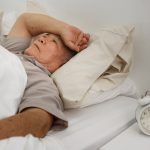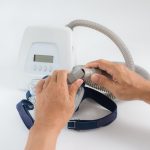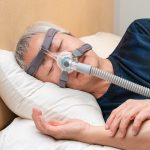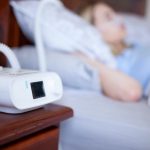Sleep Apnea Affects Men and Women Differently—Here’s What to Know
Posted by Dr. Michael Breus

Sleep apnea has a pretty stubborn—and inaccurate—reputation as a men’s health issue. Years of research has shown that men are roughly 2-3 times likely as women to develop sleep apnea, depending on age and other factors. But women with OSA often go undiagnosed, in greater numbers than men. So it’s not really clear that the gap in risk between men and women is as great as it seems. And even if we take the numbers as they are, that still leaves many millions of women around the world suffering with sleep apnea and facing the health risks that come from OSA that goes untreated.
Men and women often experience sleep apnea differently. They also each face somewhat different risk factors and may face distinct long-term challenges to health and functioning without treatment for OSA.
OSA in men vs. women: different risks and different symptoms
As I’ve said, there’s a long and robust body of research showing that OSA is more common in men than in women. Epidemiological estimates show that sleep-disordered breathing occurs in 24% of men through middle age, compared to 9% of women. Those numbers rise for both men and women with age, but a gap in prevalence remains. Among older adults, an estimated 70% of men and 56% of women experience sleep-disordered breathing.
Research show that this difference between males and females starts before adulthood. There have been relatively fewer studies of OSA in children and teenagers, but the existing research shows that starting in adolescence, OSA is more common in boys than girls. Among prepubescent children, rates of OSA are similar across gender.
Why the difference? The short answer is we don’t know for sure. But a number of factors appear to play a role.
Men and women sometimes show different symptoms.
The classic symptoms of sleep apnea—loud snoring, often accompanied by gasping and choking sounds—may appear less intensely and less frequently in women. This is NOT to say that women with OSA don’t snore, or choke and gasp in their sleep. They can and do. But many women experience a broader, more diverse, less obviously breathing-specific set of symptoms than men. Women with OSA are more likely than men to report:
- Insomnia
- Depression and anxiety
- Headache
- Restless legs
- Fatigue
- Problems with cognitive function
Men can have these symptoms too, but broadly speaking, men with OSA are more likely to report snoring and identifiable episodes of interrupted breathing during sleep. These are indicated by the gasping and choking that happens when we wake in a struggle to resume normal breathing after an apnea.
These differences that can occur in symptomology are important for patients and doctors to understand. Presenting with classic and more readily recognizable symptoms means that men may be more likely to be diagnosed with sleep apnea. Women are at higher risk for both a lack of diagnosis and a misdiagnosis of their OSA, leaving their sleep apnea untreated for longer periods of time, sometimes indefinitely. It’s possible—likely, in fact—that the gap in prevalence of OSA between men and women isn’t as large as it appears to be in scientific estimates, because of the numbers of women who have OSA and aren’t being diagnosed and treated.
It’s critical for men and women to know the range of symptoms that can occur with OSA, and how their gender may affect their symptoms, that they can monitor their own health and, for couples, stay attuned to their partner’s health. As health professionals, we must do a couple of things: recognize the fundamentally higher risk that men appear to face in sleep apnea, while also being highly watchful and attuned to the differences in ways women may show signs and symptoms of sleep apnea.
Men and women have physiological differences that affect sleep apnea
Differences in anatomy and physiology between men and women may also contribute to the difference in risk between genders. Men have longer airways than women, with more soft tissue lining those airway walls. Studies show that men’s airways are more prone to collapsing during sleep than women’s, leading to interruptions or suspensions of breathing. Men also tend to experience a greater build-up of fluid in the neck while lying down for a night’s rest, which can lead to a greater frequency and intensity of sleep-disordered breathing.
Obesity appears to be a greater risk factor for men
Obesity is more closely linked to sleep apnea in men, according to research. Among men and women with the same body mass index, men tend to have more severe OSA than women. And women with OSA tend to be more obese than men with the same severity of the sleep disorder. This may be attributed at least in part to gender differences in the way that fat is distributed across the body. Men are more likely to accumulate more fat at the waist and in the neck, areas where excess fat can have a more direct and powerful impact on sleep-disordered breathing. Studies have suggested that waist and neck circumference is a better predictor of sleep disordered breathing than body mass index, or BMI, for both men and women.
Sex hormones may play a big role in OSA gender differences
There’s been a great deal of scientific interest and attention to the role that hormones play in gender differences related to sleep apnea. The divergence of OSA risk that starts during puberty suggests that hormones including estrogen, progesterone and testosterone are likely a factor in the risk differences between men and women.
Menopause is another turning point in the OSA risk differences between men and women, and that’s another signal that sex hormones influence the onset and development of sleep apnea. Rates of sleep apnea rise significantly among women during perimenopause and menopause, when levels of progesterone and estrogen are fluctuating and on the decline. Research has shown that compared to premenopausal women, postmenopausal women are more than 3 times as likely to have sleep disordered breathing.
There’s some evidence that women who use hormone replacement therapy experience a reduction in risk for developing OSA.
The relationship between testosterone and sleep apnea is complicated, and not yet well understood. Low testosterone is often present in men with sleep apnea. But testosterone replacement therapy has been shown to make OSA worse.
There’s a lot more to learn about the relationship between sex hormones and OSA and given the numbers of men and women coping with the sleep disorder, this is critically important research. Right now, we can say that estrogen and progesterone appear to be one factor in a reduced risk of sleep apnea for women in young adulthood and middle age. The protective benefits of women’s sex hormones appear to largely expire as menopause progresses.
The health complications of OSA are different for men and women, too
Untreated sleep apnea carries with it risks for other mental and physical health problems, especially over the long-term. Cardiovascular disease, diabetes, cancer and neurodegenerative disease are among the serious conditions that may be triggered or made worse by sleep apnea that goes untreated. Men and women experience some of these secondary risks and complications differently.
I’m about to walk you through some of the specifics, but before I do, I want to be clear. This discussion relates to differences in men and women’s health specifically as it relates to sleep apnea. Gender differences exist within these health conditions apart from OSA. And male or female, a person’s individual risk is influenced by many factors, including genetics, general health and lifestyle, and environment. Please always take your questions and concerns about your personal health risks to your physician.
Cancer
Some of the most sobering emerging research about the complications of untreated sleep apnea involves its potential to contribute to increased risks for some cancers. There’s some evidence that women with severe OSA may be at greater risk for developing cancer than men with the same severity of OSA. This is pretty new scientific research and we need to see more in-depth research to get a better handle on the gender differences that may exist here. Both men and women may face higher risks for cancer if OSA is untreated, so it’s critical that everyone seek medical attention for their sleep disordered breathing and any symptoms broadly consistent with OSA. (And remember, men’s and women’ symptoms can look different.)
Cardiovascular disease and diabetes
Untreated OSA has a deep connection to heart disease and diabetes. Untreated sleep apnea significantly elevates risk for high blood pressure, heart disease, stroke, as well as diabetes and prediabetes. The question of how gender influences these risks in people with OSA is complex, and the answer isn’t yet clear. Some research shows women with OSA at a higher risk for diabetes, while other research points to men with untreated OSA as having greater diabetes risk. The research on cardiovascular disease is similarly divergent. What we do know with some clarity? Consistent use of CPAP therapy can help to reduce cardiovascular complications and risk for cardiovascular disease and diabetes in both men and women.
Brain health, cognition, and mood
OSA has been linked to changes in the structure and function of the brain, in areas responsible for complex cognition, including memory and attention, emotional processing, and mood regulation. In at least one region of the brain affected by OSA—the cerebral cortex—women appear to experience more significant structural changes than men. The cerebral cortex is a large area of gray matter the covers the two hemispheres of the brain. Different parts of the cerebral cortex are responsible for a wide range of functions, including memory, language, attention, decision making, emotional regulation and the processing of sensory information. Recent research has shown than OSA is associated with a thinning of the cerebral cortex in both men and women—and that the degree of thinning is greater for women than men. Women have been shown in studies to experience more cognitive dysfunction related to sleep apnea than men. This more aggressive thinning of the cerebral cortex may be part of the reason why.
Both men and women face an array of challenges and risks from sleep apnea that’s untreated. The differences in how the disorder affects men and women are important to understand for several reasons: to ensure a timely diagnosis by identifying symptoms correctly, to tailor treatment for men and women in ways address the full spectrum of their symptoms and secondary health issues, and to alert to potential long-term health complications, before they become a problem.
Sweet Dreams,
Michael J. Breus, PhD, DABSM
The Sleep Doctor™
www.thesleepdoctor.com












